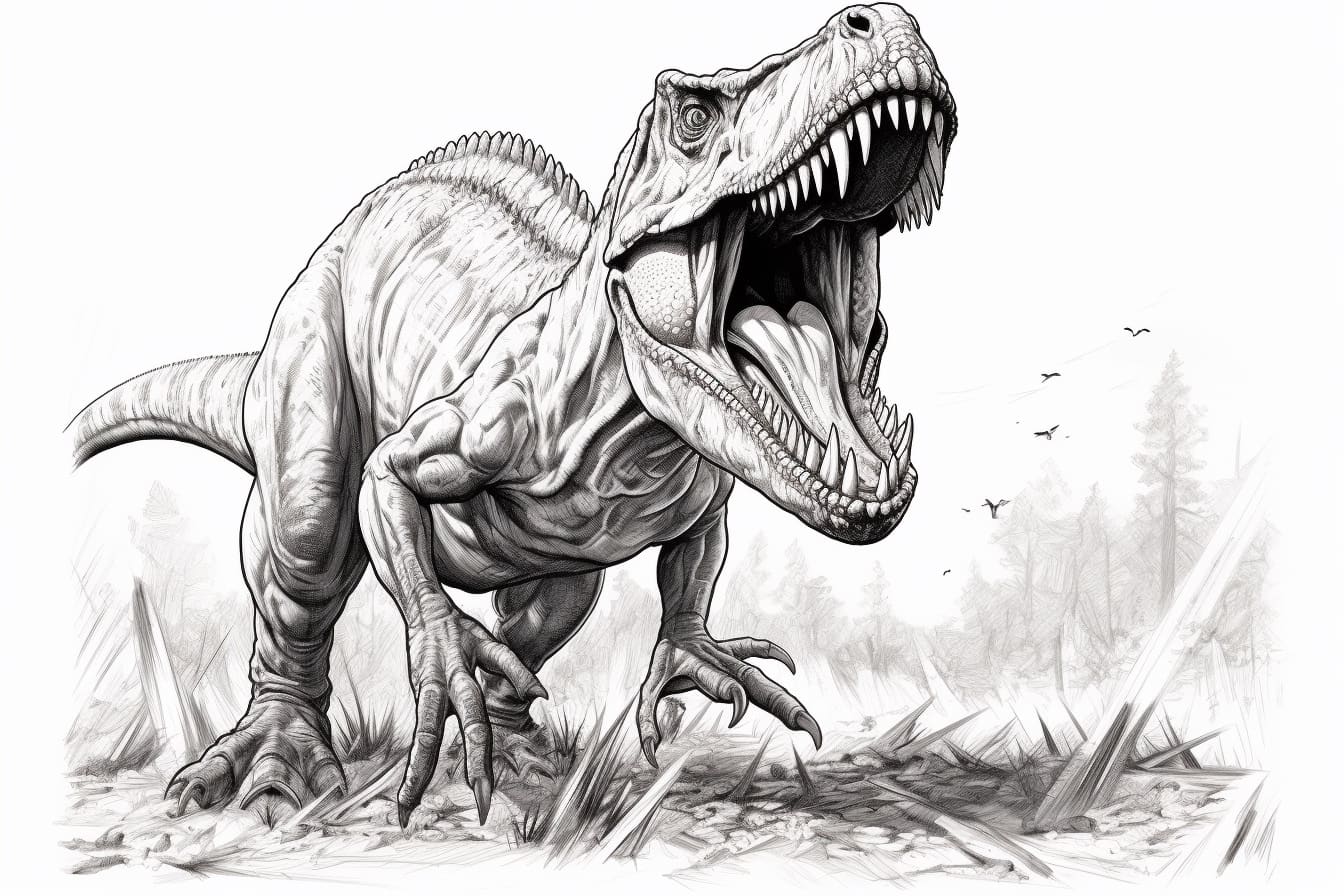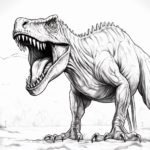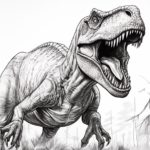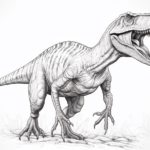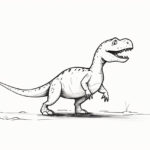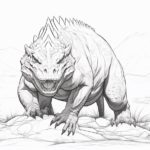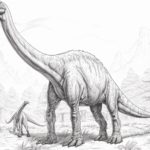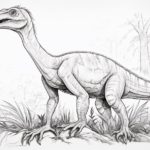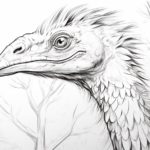Drawing Tyrannosaurus Rex is a thrilling and challenging endeavor that allows you to journey back in time to a world ruled by these magnificent and fearsome creatures. As one of the most iconic dinosaurs, the T-Rex has captured the imagination of people of all ages with its massive size, sharp teeth, and powerful presence. In this guide, we will explore the key features and characteristics of the Tyrannosaurus Rex and provide step-by-step instructions on capturing its essence on paper. So grab your pencils and let’s embark on a creative adventure into the prehistoric world of the T-Rex!
Materials Required
Before we begin, gather the following materials:
- Pencil
- Eraser
- Drawing paper
- Fine-tip black marker
- Colored pencils or markers (optional)
Now that we have our materials ready, let’s dive into the steps involved in drawing a T-Rex.
How to Draw a Tyrannosaurus Rex: a Step-by-step Guide
Step 1: Gather Your Materials
- Gather all the necessary materials for drawing, including paper, pencil, eraser, and any coloring materials you may want to use.
Step 2: Start with Basic Shapes
- Begin by sketching the basic shapes to outline the body of the Tyrannosaurus Rex. Start with an oval for the head, a large oval for the body, and smaller ovals for the limbs.
Step 3: Add Details to the Head
- Add details to the head by drawing the mouth, eye sockets, and the characteristic ridges on top of the skull. Pay attention to the shape of the jaw and the sharp teeth.
Step 4: Outline the Body
- Use the large oval as a guide to outline the body of the T-Rex. Add the neck, back, and tail, making sure to capture the massive and powerful appearance of the dinosaur.
Step 5: Draw the Limbs
- Sketch the limbs of the Tyrannosaurus Rex, paying attention to the muscular structure and the sharp claws on its feet. Make sure the proportions are correct to support the weight of the dinosaur.
Step 6: Refine the Details
- Refine the details of the T-Rex by adding scales to its skin, defining the muscles, and adding texture to different body parts. Take your time to make the dinosaur look realistic and intimidating.
Step 7: Erase Guidelines
- Use an eraser to carefully erase any guidelines or rough sketches that are no longer needed. This will help clean up the drawing and make the T-Rex stand out.
Step 8: Add Color (Optional)
- If you wish to add color to your drawing, use colored pencils, markers, or paints to bring your Tyrannosaurus Rex to life. Consider using earth tones and greens to mimic its natural habitat.
Step 9: Final Touches
- Take a step back and review your drawing of the Tyrannosaurus Rex. Make any final adjustments or additions to enhance the overall appearance and ensure it looks fierce and realistic.
Step 10: Sign and Date Your Artwork
- Once you are satisfied with your drawing, don’t forget to sign and date your artwork. This will give your piece a personal touch and mark its completion.
Conclusion
In conclusion, drawing a Tyrannosaurus Rex can be a challenging yet rewarding artistic endeavor. By breaking down the process into simple shapes, focusing on proportions and details, and practicing regularly, artists of all skill levels can create impressive and lifelike representations of this iconic dinosaur. Remember to have fun with the process and experiment with different techniques to truly bring your T-Rex drawings to life. With dedication and patience, anyone can master the art of drawing this fearsome creature.
Fun Facts About Tyrannosaurus Rexes
- Tyrannosaurus Rex, also known as T. Rex, lived during the Late Cretaceous period, approximately 68 to 66 million years ago.
- T. Rex is one of the largest known carnivorous dinosaurs, with adults reaching lengths of up to 40 feet and weighing as much as 9 tons.
- Its name, Tyrannosaurus Rex, means “Tyrant Lizard King” in Latin, reflecting its powerful and dominant presence in the prehistoric world.
- T. Rex had one of the strongest bite forces of any land animal in history, estimated to be between 8,000 to 12,000 pounds per square inch, allowing it to crush bone with ease.
- Despite its reputation as a fearsome predator, T. Rex may have had a limited sense of smell, relying more on its exceptional vision and hearing to locate prey.
- Recent studies suggest that T. Rex may have been covered in feathers, particularly as juveniles, providing insulation and possibly aiding in display or camouflage.
- T. Rex had long, powerful hind limbs that allowed it to run at speeds of up to 25 miles per hour, making it a formidable hunter on the prehistoric plains.
- The arms of T. Rex were relatively small compared to its massive body, leading to ongoing debate among scientists about their function, with some suggesting they may have been used for grasping or balancing during mating.
- T. Rex had serrated teeth that were constantly replaced throughout its life, with new teeth growing in to replace worn or broken ones, ensuring its ability to continue hunting and feeding effectively.
- The discovery of well-preserved T. Rex fossils has provided valuable insights into the anatomy, behavior, and ecology of this iconic dinosaur, helping to shape our understanding of the prehistoric world.
Suggestions for Scenes and Settings for Tyrannosaurus Rex Drawings
- Tyrannosaurus Rex in a dense prehistoric jungle, with towering ferns and ancient trees creating a mysterious and atmospheric setting.
- Tyrannosaurus Rex emerging from a dark, misty swamp, with murky waters and twisted roots adding a sense of danger and intrigue.
- Tyrannosaurus Rex in a dramatic volcanic landscape, with billowing smoke and fiery lava flows creating a dynamic and intense backdrop.
- Tyrannosaurus Rex hunting its prey in a vast open grassland, with rolling hills and a wide expanse of sky conveying a sense of freedom and movement.
- Tyrannosaurus Rex in a snowy, wintry scene, with snow-covered mountains and frosty trees evoking a sense of cold and harsh conditions.
- Tyrannosaurus Rex in a desert setting, with towering sand dunes and a blazing sun overhead creating a stark and unforgiving environment.
- Tyrannosaurus Rex in a rocky canyon, with towering cliffs and twisted rock formations adding a sense of rugged beauty and ancient history.
- Tyrannosaurus Rex in a futuristic cityscape, with skyscrapers and flying vehicles hinting at a world where dinosaurs and technology coexist.
- Tyrannosaurus Rex in a post-apocalyptic wasteland, with crumbling buildings and overgrown vegetation symbolizing a world reclaimed by nature.
- Tyrannosaurus Rex in a fantastical realm, with floating islands and magical creatures populating a vibrant and otherworldly setting.

